Snake bites on dogs can be a common and painful—or even deadly—problem in some areas of the country. Integrative veterinarian Dr. Julie Buzby invites her friend Dr. Jessica Harris, who lives in rattlesnake country, to give you the need-to-know details. Learn dog snake bite symptoms, what to do if your dog gets bitten by a snake, and how to prevent snake bites in dogs.
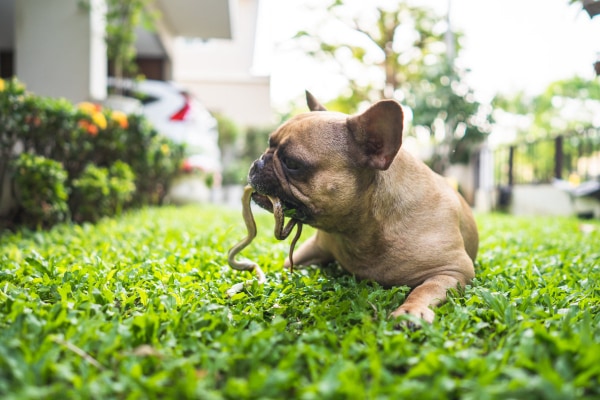
Warm weather usually brings lots of fun activities and things to look forward to—gardening, camping, hiking, swimming, walks through the park, BBQs, golfing, and more. However, the warmer temperatures also mean more insects and pests are active.
Unfortunately, this puts your beloved dog at an increased risk of being bitten by a bug (including mosquitos, which carry heartworm disease in dogs, and ticks, which can transmit tick-borne diseases in dogs). Plus, in some areas of the country, hot weather is the prime time for snake bites on dogs.
Last summer, my client brought her 7-year-old Golden Retriever, Miley, to my office. Miley suffered a copperhead snake bite while on a bike ride with her mom. Thankfully, my client and I had previously discussed what to do in this situation. So, she knew exactly what steps to take, including getting her pup to the vet clinic for treatment ASAP.
Since being prepared, like Miley’s mom was, is so important, let’s take a closer look at snake bites on dogs. We’ll discuss topics like dog snake bite symptoms, what you should do if your dog has been bitten, snake bite treatment, and how to prevent future bites.
When is my dog at risk for snake bites?
The first order of business is to discuss a bit of snake biology. During winter and cold days, snakes are most likely to be burrowed underground or in other hiding spots. Therefore, your dog has the highest chance of encountering a snake in warm weather. This is because snakes are cold-blooded animals. They must seek heat to keep their body temperature warm enough.
Snakes can be found in many different climates—ranging from wetlands (like swamps, marshes, or lakes) to dry, hot deserts. They may be sunbathing on a warm rock, sleeping under a bush or in the shade, or swimming in the water.
If you encounter a snake, you should carefully back away and ensure that you and your dog give the snake its space. However, sometimes your dog might be walking or running off-leash. And depending on the circumstances, even if you see a snake and have time to react and move away, your dog might not know (or have time) to do the same.
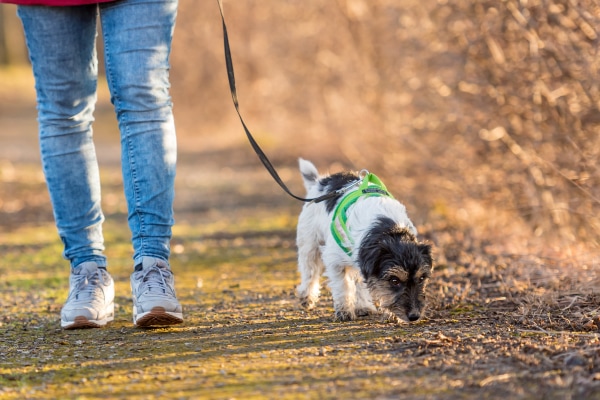
What are dog snake bite symptoms?
Snakebite wounds are most common on the legs and paws since dogs often accidentally step on or run right next to the snake. The face, nose, and neck are the other likely spots for a snake bite on a dog to occur. This is because dogs are curious and stick their noses right up to the snake in order to investigate it.
When a snake bites your dog, your poor pup will likely vocalize loudly. The loud yelp comes from both the shock and pain of the bite. If you hear your dog cry out, it is important that you closely examine him or her—but first, ensure that your dog (and you) is safely out of the snake’s reach.
The site of the bite and the clinical signs will vary depending on what type of snake bit your dog. However, in most cases, the affected area might look red and swollen. If your dog does not have long hair, you might be able to see two distinct puncture wounds from the snake’s fangs. These wounds are likely to bleed—and they might bleed a lot.
Additionally, the bite site will likely be extremely painful. Your dog might be holding up the affected leg and refusing to walk on it. Or, he or she may be holding their neck and head at an odd angle if the snake bite occurs in those regions.
Symptoms of a venomous snake bite
If a venomous snake bit your dog, the symptoms will progress faster and be more severe. In cases of a venomous bite, your dog might:
- Suddenly appear weak and collapse (This is a very common sign of snake bites. However, other diseases like heart disease in dogs can cause this symptom as well.)
- Experience paralysis and be unable to stand or move
- Excessively drool or froth at the mouth
- Have dilated pupils
- Tremble or shake
- Experience seizures in dogs
- Involuntarily urinate or defecate
- Have bloody urine
- Vomit or have diarrhea
- Have pale, whitish gums
- Experience difficulty swallowing and breathing (i.e. a dog breathing fast)
The slideshow below includes photos of dogs with snakebites.
Factors that influence a dog’s snake bite symptoms
The severity of these symptoms is heavily dependent on what type of snake bit your dog, the amount of snake venom injected, the size of your dog, and the location of the wound.
- Venomous snake bites can progress quickly and be fatal. On the other hand, non-venomous snake bites are extremely painful and can cause localized injury. But they are less likely to cause systemic (i.e. whole-body) reactions like paralysis.
- Young snakes typically inject larger quantities of venom than their adult counterparts.
- Small dogs are more likely to have rapid, severe effects because it takes less time for the venom to circulate through the whole body than it would for a larger dog.
- Dogs with a bite on the paw or tail usually have a little more time before the venom spreads since these locations are farther from the heart.
- Dogs who are bitten in the face or neck are more likely to experience respiratory symptoms because the localized swelling associated with the bite can put pressure on the throat and airways.
Since snake bites can vary so much, it is important to closely examine your dog after a possible bite and react quickly.
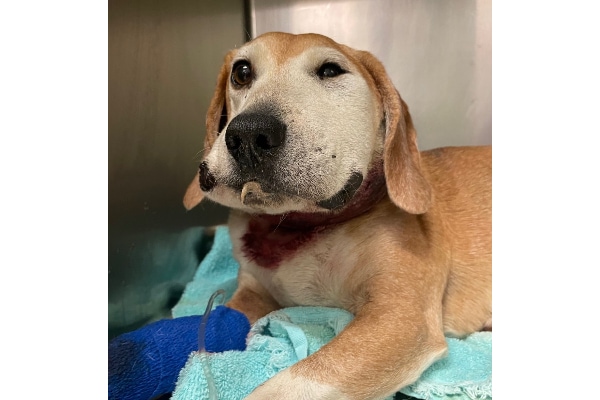
What should you do for snake bites on dogs?
If you think a snake bit your dog, the first thing to do is ensure that you and your dog are both out of the snake’s reach. You can’t help your dog if the snake bites you too, so it is important to protect yourself.
Next, you should try to safely identify the snake. If you don’t know different snake types, take a picture or video of the snake if possible. Knowing what type of snake bit your dog will be very helpful for your veterinarian when determining what kind of treatment your dog needs.
But again, do not do anything that will put you at risk of a snake bite. And please do not try to catch or kill the snake.
First aid for snake bites
Your next task is to quickly assess your dog. But remember, regardless of what type of snake bit your dog, these injuries are very painful. Please use extreme caution when examining your dog’s body for a snake bite. Even the best and sweetest dogs can bite when in pain and trying to protect themselves.
If you feel that you can safely look at your dog’s wound, quickly do so to assess the situation. Should your dog not be breathing, you may need to start CPR (or call an emergency vet for instructions). Otherwise, if your dog appears stable, move your dog enough to get him or her in the car. Then go straight to the veterinary hospital for an emergency vet visit.
When moving your dog, try to keep the area of the bite still and below the level of the heart. Decreasing movement and keeping the wound lower than the heart will help slow the blood flow from the area and decrease the speed at which the venom spreads. If you are out hiking or camping and need to walk back to your car, this means you will probably need to carry your dog.
Dos and don’ts
Before walking, you may rinse out the wound with water to try to wash away some of the venom that is lingering on the surface. However, you should not do anything else to the bite wound, because you do not want to risk increasing the venom’s spread. Keep these rules in mind:
- Do not put a cold or hot pack on the bite site. (This can increase circulation and speed up the venom spread.)
- Do not move or manipulate the bitten area. (Again, this can increase circulation.)
- Do not try to suck out the venom.
- Do not give your dog milk to drink to neutralize the venom of the snake bite.
- Do not put a raw egg on the bite wound.
- Do not try to urinate on the wound to counteract the venom. (Snake bites are not like jellyfish stings.)
- Do not allow your dog to walk or run around. (This increases the heart rate and the speed of venom spread.)
- Do not administer any medications without talking with your veterinarian first.
Remain calm and get your dog to the vet ASAP
Also, while helping your dog, it is important that you remain calm. Dogs can easily detect stress—especially in the humans they love. If your dog becomes stressed, this will increase his or her heart rate, which will also increase the speed of the venom’s spread throughout your dog’s body.
The most important job you have is to keep your dog still and calm and get him or her to a veterinarian quickly.
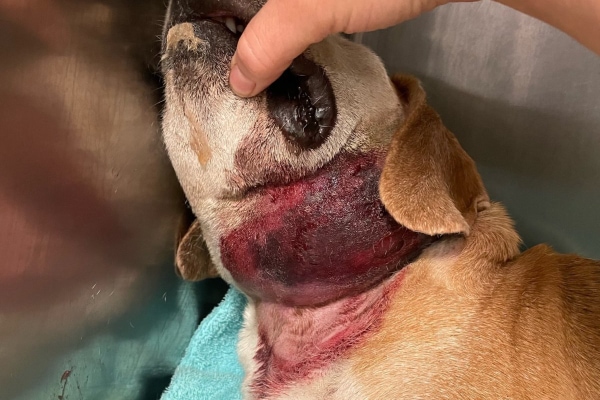
Can I provide home treatment for my dog’s snake bite?
I want to emphasize to you that while appropriate first aid is great, home treatment is not sufficient for snake bites. Every snake bite case should be seen by a veterinarian as soon as possible.
Venomous snake bites can cause severe, obvious, and fatal effects. However, non-venomous bites can also be dangerous. While these snake bites may appear minor with only some localized swelling and pain, they can have long-term effects that cause tissue damage. Or, they may slowly cause damage to clotting factors in the blood, which may prevent your dog from clotting and healing as he or she normally would. For these reasons, treating snake bites is best left to your veterinarian.
If a snake bites your dog, your number one goal should be to seek help from the closest veterinary clinic (and ensure you stay safe of course).
The timeline for each snake bite is different, so it is best to act quickly. A snake bite can kill a dog so you need to take it seriously. (This is the case even if your dog has received the rattlesnake vaccine because the vaccine doesn’t necessarily keep the dog from dying from a bite).
What can you expect when you get to the clinic?
When you arrive at the vet clinic with your dog, the veterinary staff will quickly assess your dog as you walk through the door. If your dog is in severe condition, the vet staff might take your dog straight back to the treatment area without you in order to stabilize your dog quickly. But if a non-venomous snake bit your dog, and your dog is stable, the veterinary team will likely begin with questions and a physical examination.
When talking to the veterinary team, it is important to describe where you were walking and what the snake looked like (or show the picture that you took). These details will help your vet determine what kind of snake bite your dog is experiencing.
Your vet will also ask about what you have done to help your dog after the bite. It is important that you tell your vet everything that you did or gave your dog. This information could impact which treatment plan is best for your dog.
Chances are, your veterinarian will recommend a series of diagnostic tests and begin treatment at the same time. Diagnostic testing and monitoring might include:
- Measuring blood pressure
- Performing blood work and a urinalysis
- Taking X-rays
- Assessing oxygen saturation levels
What is the treatment for dog snake bites?
Treatment will depend on the type of snake that bit your dog and your dog’s clinical symptoms.
Antivenom
If your dog was bit by a venomous snake (like a rattlesnake), antivenom is the only treatment option that can neutralize the venom from the bite and truly treat your dog. While there are other treatments that can help provide support and stabilize your dog, they will not be able to combat the venom if it was a venomous snake. The best way to accomplish this is by administering antivenom (sometimes called antivenin).
Without this antivenom, your dog will continue to experience the effects of the venom such as bleeding, bruising, swelling, tissue damage, and other long term affects. In many cases, a dog cannot survive a rattlesnake or other venomous snake bite without treatment.
Therefore, if you and your veterinarian don’t know if the snake was venomous, it is best for your dog to receive antivenom.
Once the veterinarian administers antivenom, he or she will want to closely monitor your dog. Some dogs will have an allergic reaction to the antivenom and need additional treatments.
While antivenom is the gold-standard treatment for venomous snake bites and is the most effective option, it can be expensive to administer. And unfortunately, not all veterinary hospitals have antivenom on hand to use for snake bites. Therefore, avoiding snake bites and taking preventative measures is the best option to keep your dog safe.
Additional supportive treatment
In addition to antivenom, many dogs will need additional supportive treatment—especially if they are in critical condition. And if your dog is bit by a non-venomous snake, the treatments below may still be used.
Oxygen support
Providing supplemental oxygen can help your dog breathe better. This is especially the case for dogs with a snake bite on the face and significant face or neck swelling.
IV fluid therapy
The vet will administer IV fluids to combat shock and help prevent your dog’s blood pressure from dropping too low. Having an IV line in place also gives the veterinarian a quick way to administer medications in an emergency situation.
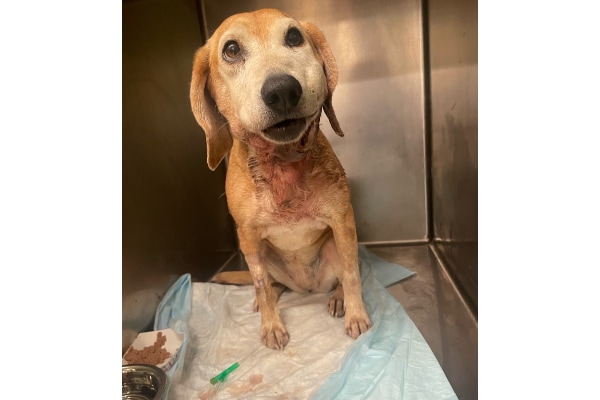
Anti-convulsants
If your dog is seizing or convulsing after a snake bite, your vet might give medications to help stop the seizure activity.
Pain medication
Snake bites are extremely painful whether your dog was bit by a venomous snake or not. So, most dogs who are bit by a snake will need pain medications. Non-steroidal anti-inflammatories (NSAIDs) are usually avoided because they can increase the risk of bleeding. With envenomation, bleeding risks are already higher, so it is important to avoid anything that can make bleeding even worse.
However, there are other pain medication options that your veterinarian might use to keep your dog comfortable while still being safe.
Antihistamines
Antihistamines are not usually used for treating the initial snake bite (especially a venomous snake bite). However, some dogs may have allergic reactions to the antivenom treatment. In these cases, your dog may need treatment to combat the allergic reaction to the antivenom.
Antibiotics
Vets don’t usually use antibiotics for snake bites in dogs during the initial treatment plan. However, sometimes the bite wound can become infected later on. If there is evidence of infection at the bite site, antibiotics might be used.
How should you monitor your dog after discharge from your vet?
On average, most veterinarians will want to monitor dogs for 24-48 hours after a snake bite. This is especially the case for venomous snake bites.
After completing all in-hospital treatment and monitoring, your vet will discharge your dog from the hospital. However, being discharged does not mean that your dog is cured. Snake bite recovery can be long and painful depending on what kind of snake bit your dog. Therefore, good aftercare is very important to prevent long-term effects.
Administer medications as directed
At home, it is important to continue any medications that your veterinarian prescribed for your dog. You must administer them exactly as directed by the vet on the prescription label. This is key to managing the pain your dog is experiencing and decreasing the chance of complications.
Also, you must not give your dog any additional medications that were not prescribed or recommended by your veterinarian. If you are unsure what you can give your dog for his or her snake bite, please contact your veterinarian.
Keep the bite wound clean
Additionally, you will need to keep the area around the snake bite marks clean. Your veterinarian will tell you if you should actually clean the wound or just prevent it from becoming contaminated. The most important step is to keep your dog from licking, biting, or scratching the area. Also, you should prevent your dog from rolling in the dirt or mud.

Watch your dog very carefully for the first 3-5 days
The most crucial time period to monitor your dog is the first 3-5 days after the snake bite. This is when your dog is at the highest risk for an allergic reaction, necrosis of the skin (i.e. the skin turns black and dies), or other secondary complications from the snake bite.
What is the prognosis for snake bites on dogs?
Most dogs will heal from a snake bite after receiving prompt and proper care. But there are some cases where a secondary complication occurs, such as:
- An anaphylactic reaction that results in death
- Blood clotting disorder
- Organ failure (This is most common in senior dogs or dogs with other concurrent diseases like kidney failure in dogs.)
The best way to improve your dog’s prognosis after a snake bite is by quickly seeking veterinary care, following your veterinarian’s recommendations at home, and closely monitoring your dog for any changes or new symptoms.
How can you prevent snake bites in dogs?
While snake bites can be treated, it is much easier (and far more ideal) to prevent them from happening in the first place. Following these prevention tips can help.
1. Know your local snakes
To effectively prevent snake bites, you should know what kind of snakes live in your local area. Do you need to avoid letting your dog swim during certain seasons because of water moccasins? Do you have rattlesnakes that like to hide in rocks and tall grasses? If you don’t know what kind of snakes live nearby, you won’t know what types of environments they live in and how to avoid them.
Additionally, you should know if the local snakes are venomous or not. As discussed above, this is important information that can guide your vet’s treatment of your dog’s snake bite.
While I can’t discuss every kind of snake that exists, here are some of the most common ones that you might encounter.
Non-venomous snakes:
These snakes can still bite your dog, but they do not inject venom. Typically, their bites are not deadly. However, bites can still be very painful, so you should always take your dog to the vet if you suspect he or she was bitten by a snake. Some common non-venomous snakes include:
- Garter snakes (common in most states)
- Boas
- Pythons
- Kingsnakes
Venomous snakes
These snakes have fangs that penetrate a dog’s skin and inject a toxic venom. In many cases, baby snakes transfer more venom with a bite than adult snakes do. But, even a dying snake can still inject venom through a bite. Each snake venom has different effects, but the results are more severe than a non-venomous bite.
There are two main categories of venomous snakes:
- Crotalidae—The snakes in this family greatly outnumber other types of venomous snakes. They are found in most of the United States and cause a greater percentage of dog snake bites. Rattlesnakes, cottonmouths, copperheads, and pit vipers are common and well-known snakes in this family.
- Elapidae—Snake bites from this family of snakes are fairly rare. They have much lower populations in the United States and are usually only found in the southernmost part of the country. However, Elapidae bites are always an emergency. Their venom has toxins that prevent muscles (including the ones used for breathing) from contracting. Coral snakes are the most well-known snake in this family.
2. Decrease exposure to snakes

If you live in an area where snakes (especially venomous ones) are common, it is best to avoid exposure to the snakes completely. However, I know this isn’t always possible. Some snake bite prevention tips include:
- Stay on the path when hiking—While snakes may slither across the clear path, many will want to hide in the rocks and bushes where they are protected and cool. Therefore, you should avoid walking, and letting your dog run through, tall grasses and weeds.
- Do not let your dog stick his or her nose in holes that could be snake holes (whether in the ground or a pile of rocks).
- If you see a snake, recall your dog immediately and put him or her on a leash. If your dog is tempted to play with snakes, it might be best to keep him or her on a leash during snake season.
- At home, keep your yard and house clear of environments where snakes might want to live. Snakes find long grasses, piles of wood, and shady spots the most comfortable to hide in. Eliminating these hiding spots can decrease the risk of snakes in your yard.
- Ask a professional pest control company to come to your house. These companies have animal and kid-safe snake deterrents that can be applied to the perimeter of your house and property to reduce the likelihood of a snake entering. Of course, these deterrents are not 100% effective, but they usually do decrease the risk. Additionally, a pest control company can safely remove any snakes that you know are living at your house.
3. Ask your vet about the rattlesnake vaccine
I often get asked about the western diamondback rattlesnake vaccine. This is a topic that veterinarians have differing opinions on. As indicated in the American Animal Hospital Association (AAHA) rattlesnake vaccine guidelines, there is very little scientific data showing whether vaccination truly helps decrease the effects of envenomation or not.
It is also important to note that the rattlesnake vaccine does not make a dog immune to a rattlesnake bite. Even vaccinated dogs must receive treatment from a veterinarian. The idea behind the vaccine is simply to decrease the effects of the venomous bite and give the dog parent more time to get their dog to the veterinary hospital.
However, as I said above, there is very little data proving that the vaccine provides the intended benefits. Additionally, the rattlesnake vaccine can sometimes cause local irritation and swelling and is also more likely to cause an allergic reaction than other vaccines.
Therefore, if you live in (or frequently visit) an area with western diamondback rattlesnakes, please discuss the vaccine with your veterinarian. Together, you can decide if the benefits outweigh the risks of the vaccination for your dog.
4. Consider snake avoidance training
Instead of the snake vaccine, snake avoidance training can be an effective tool for dogs at an increased risk of encountering snakes. This type of training is usually offered through a professional dog trainer (and often through a local wildlife department). It teaches dogs to avoid snakes, rather than approach them and get bit while investigating.
If you are interested in this type of training for your dog, ask your veterinarian if he or she recommends a particular trainer or class.
5. Examine your dog daily
Finally, if you live in an area that is heavily populated by snakes, it is important to check your dog for snake bites every day.
If your dog is always with you and on a leash, you are more likely to know immediately if your dog got bit by a snake. However, if your dog spends time in the yard or running off-leash on a walk, it is possible that he or she could be bit by a snake without you knowing immediately. Remember, dogs can be very good at hiding pain—especially if they are excited and having fun outside.
I recommend checking your dog every day (and sometimes multiple times a day) for evidence of snake bites. At the same time, you can also examine your dogs for fleas, ticks, or other new problems. Early detection (and early treatment) is just as important as prevention in many cases!
If you are not sure how to examine your dog thoroughly or don’t know what to look for, I recommend taking Dr. Buzby’s Tip-to-Tail Dog Health Scan™ course. This online course will teach you how to effectively perform a 5-minute exam on your dog at home. Not only can you use this method to look for snake bites, but it is a great way to monitor your dog on a regular basis.
Since our dogs can’t talk, close monitoring is very important. Your furry friend relies on you to advocate for him or her—whether it’s for a snake bite or some other condition.
Know what to do for (and how to avoid) snake bites
Snake bites, like many emergencies, are a situation where knowledge is power. If you live somewhere with a higher number of snakes (or if you are visiting such an area), it is important to know how to avoid contact with snakes and what to do if your dog does get bitten. Miley (the Golden I mentioned at the beginning of this article) made a full recovery, thanks in no small part to her mom’s quick thinking under pressure.
Keep in mind that the best thing you can do for a snake bite is to stay calm and stay safe, keep your dog as still as possible, and get your dog to the vet ASAP. Together, you and your vet can help your dog recover from a snake bite.
Has your dog ever had an encounter with a snake?
Please share your tips below.


I’m guessing that Dr. Harris is familiar with (or a contributor to!) the FB group, National Snakebite Support, https://www.facebook.com/share/g/etKVZxYPAoCcHPQP/?mibextid=K35XfP
I highly recommend that anyone living in an area with venomous snakes join this group which is administered by vets – only vets and the moderators can respond to a poster. They have easy to read and understand Do’s and Don’ts in easy to print out pictures. Many vets still use old protocols that are, as Dr. Harris pointed out, unnecessary and ineffective.
If you are in an area where venomous snakes roam, know which veterinary clinics carry antivenom NOW, not if a bite occurs. It saves time. Also, the University of Florida Gainesville is the only vet hospital in the US that carries coral snake antivenom. Know also that while pit viper bites usually become noticeable fairly rapidly, coral snake envenomations can take up to 8 hours and the result is respiratory arrest so veterinary attention is a must.
Hi Karen,
Yes, Dr. Harris is familiar with the National Snakebite Support group! Thank you for posting the link and the wonderful recommendations. I am glad you added the information about coral snakes. We can all do better when we work together and share knowledge. I appreciate you taking the time to comment. Keep up the good work!
My pup was bitten at 10 pm by a snake in the middle of a residential road. I never would have thought it was possible to get bitten at NIGHT!
My advice… if it happens… call the emergency vet and let them know you are on your way. The first vet I went to was OUT of the antivenom… Had I known I could have saved precious time.
My girl survived and seems to be on the mend..
Hi Linda,
How scary! I am so sorry you were thrown into this emergency situation. Glad to hear your girl made it through the critical period and is showing improvement. Thanks for sharing your story and offering this great advice about calling ahead to the ER. Best wishes to you and your sweet girl.